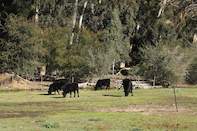Cattle in South Africa belong to a class of animals that are known as ruminants, because they have four compartments to their stomach and chew their cud. The Beef Cattle digestive system allows ruminants to digest forages that single stomach animals, such as poultry or swine, and humans are unable to digest. To feed beef cattle efficiently, a farmer needs to understand the digestive process.

When the cow first eats, it chews its food just enough to swallow it. The food then travels to the first two stomachs, namely the rumen and the reticulum.
The rumen is the largest compartment of the cattle’s stomach and is filled with billions of bacteria, protozoa, moulds and yeast that do most of the digestion of feed for the cow.
These microbial organisms are highly adaptable, allowing cattle to ingest a large variety of feeds, from grass and hay to corn stalks and silage. Different microbes, however, are responsible for digesting different feeds, which is why cattle are sensitive to sudden changes in their diets.
As a matter of fact, sudden changes to their diet can actually be lethal, so new food should be introduced slowly.
The microbes produce volatile fatty acids, which are absorbed directly through the rumen wall and supply up to 80% of the energy needed by a cow, as well as protein, essential amino acids and certain vitamins from digested plant fibre.
Since the microbes can use nitrogen to make protein, the cows are able to eat urea and other sources of non-protein that would kill non-ruminants.
For microbes to work efficiently, the food should be in small pieces. Cows therefore regurgitate and re-chew their food several times, a process known as rumination.
The reticulum helps to trap large feed particles, first to prevent it from going onto the next section of the stomach and secondly to collect it for additional rumination. The reticulum looks like a honeycomb and also helps to trap foreign objects that could damage the stomach.
The omasum is the third compartment. Amongst others, it works like a filter sending large particles back to the reticulum and rumen, while allowing small particles to move through to the abomasum, which is also known as the “true stomach.”
Another function of the omasum, is to squeeze water from the feed, aiding the production of saliva, which is important in the rumination process.
The abomasum works almost like the human stomach, producing acid and enzymes to digest protein. Workings of the lower digestive tract in the small intestine and large intestine is similar to that of single stomach animals.